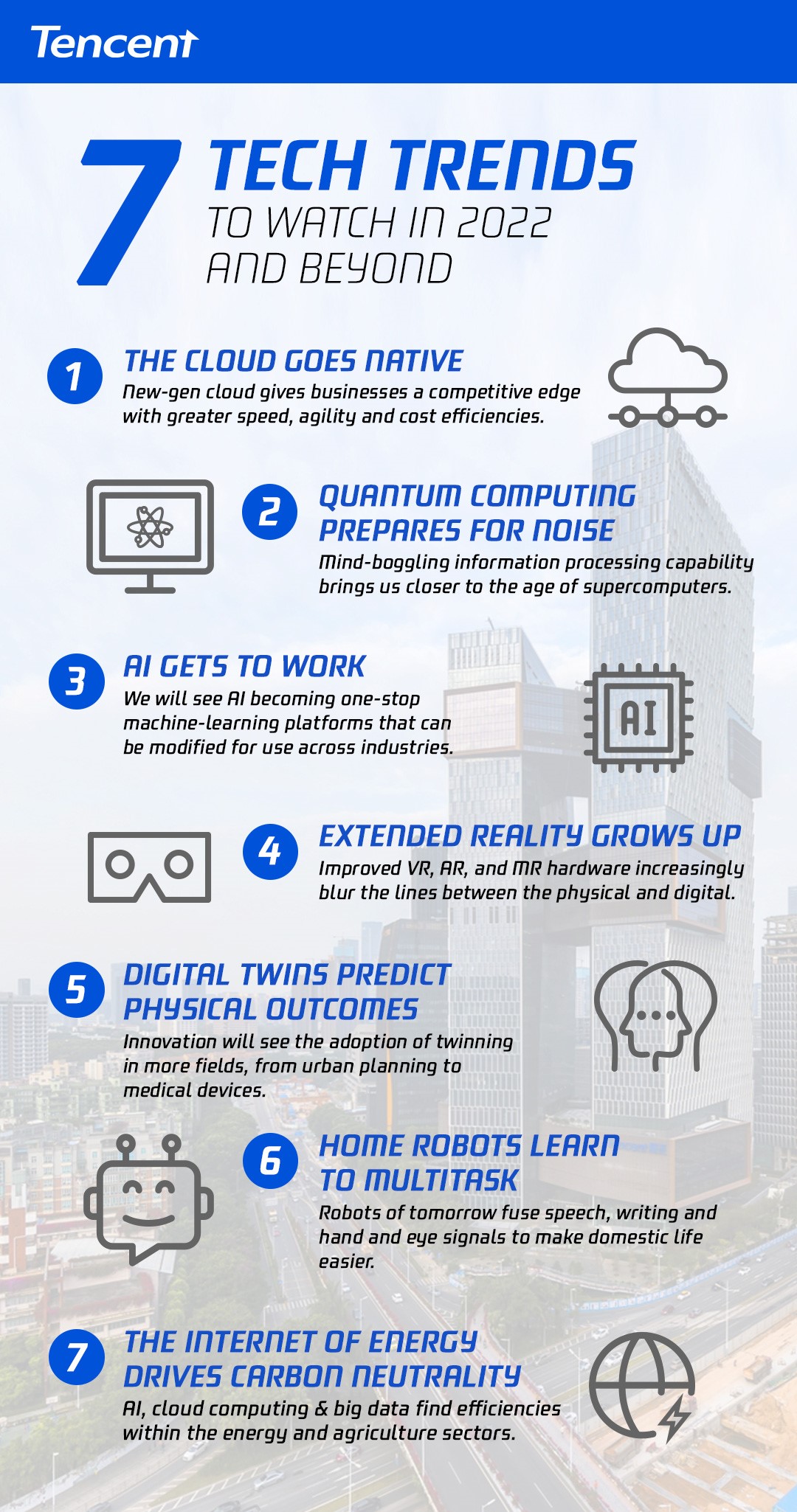7 Tech Trends to Watch in 2022 and Beyond

Technological uptake and advancements have occurred at a dizzying pace in recent years. The pace of innovation remains undiminished, with enhancements and developments promising greater benefits for businesses, individuals, and society.
Last month, we highlighted five major innovations to look out for from within the Tencent ecosystem. This month, our panel of experts highlights seven international technology trends that will shape our world and lives in 2022 and beyond.
1. The Cloud Goes Native
Containers, service meshes, microservices, and declarative APIs. Cloud computing terms are a veritable word salad! Luckily, you don’t need to know the jargon of cloud native architecture to understand that it’s good for business.
Cloud computing empowers organizations to build and run scalable applications in modern, dynamic environments. It replaces the cumbersome servers of old with external cloud solutions that provide speed and agility without compromise.
Going cloud-native also sets a lower threshold for dynamic new startups to market while delivering power efficiencies that enable big data processing. Such efficiencies are critical to driving the next generation of artificial intelligence (AI), machine learning, autonomous vehicles, analytics, and science.
2. Quantum Computing Prepares for Noise
2021 was a big year for quantum computing. Startups in the field surpassed US$1.7 billion in venture capital funding, while the scale and speed of quantum computers reached new heights.
The number of qubits, the basic unit of information within quantum computing, recently entered the triple digits. For reference, most personal computers have 32-bit processors. The higher the number, the larger amount of information that can be processed at speeds far quicker than any laptop.
The industry is now in the era of noisy intermediate-scale quantum (NISQ). The industry is working hard to increase the number of qubits and improve the quality of individual qubits.
Scientists are excited by the possibilities and expect further breakthroughs soon. Once achieved, we can expect to see large-scale uptake in finance, automotive, aerospace, AI, chemical and pharmaceutical industries, among others.
3. AI Gets to Work
AI has shown its worth in a range of environments, including hospitals and nursing homes, and in assisting disadvantaged populations such as people with hearing impairments.
Until recently, however, an AI trained for use at a hospital would not be able to do any other job. Scientists and engineers are now working to create one-stop machine learning platforms which will allow AI models to train in multiple areas.
The benefits are significant. Large models usually train on large datasets using self-supervised learning methods. After training, some fine-tuning or secondary training with a small amount of data, the AI can meet the new application field and be used in various settings, including for industrial purposes.
With countries speeding up efforts to improve AI related governance and ethics standards, AI is set to be a daily feature of life and business.
4. Extended Reality Grows Up
Companies are investing heavily in hardware for the maturing extended reality (XR) industry that will increasingly blur the lines between physical and digital experiences.
XR includes virtual reality (VR), augmented reality (AR), and mixed reality (MR). Among them, VR is the most developed and used. We expect to see leaps in ultra-short-throw optical designs that allow large images projected from short distances, Micro-OLED for even more brilliant displays, and lighter interactive controllers and thinner headsets for greater comfort.
Not just for games, VR will be increasingly used for entertainment, travel and tourism, education, and real estate. AR is catching up, with improvements being made in computing power, battery life, real-time environment recognition, and virtual and real interaction.
5. Digital Twins Predict Physical Outcomes
As products become more complex, the concept of digital twins becomes critical. These are computer-generated models identical to a physical object we are trying to build in real life.
The model allows us to simulate, test and gather useful information on a product — all from the screen of a computer. It’s cost-effective, safe, and helps us understand and optimize a physical product or environment.
Innovation will see the adoption of twinning in more fields, from urban planning to medical devices. By integrating a host of technology — from 3D modeling, AI, AR and VR to cloud rendering — we will gain unprecedented insights into the material world.
6. Home Robots Learn to Multitask
We already use robots in structured industrial and commercial settings such as factories or labs. And we use them at home for voice-activated commands like playing our favorite songs through smart speakers.
Fantastic, right? Not quite. The unstructured nature of domestic life has made their use for complex tasks challenging. The advent of multimodal fusion, however, brings them one step closer to an everyday reality. This process fuses various elements needed for effective human-computer interaction, including speech, writing and hand and eye signals.
Combined with advances in haptic technology, which allows robots to feel and handle irregular and delicate objects, and the future of home robots that make your life easier is around the corner.
7. The Internet of Energy Drives Carbon Neutrality
More than 130 countries have committed to reach net-zero emissions by 2060, and the Internet of Energy (IoE) is key to achieving such an ambitious goal. One solution is to replace high-polluting fossil fuels with greener power such as wind and solar.
But it’s also about finding efficiencies within the energy sector if we are to become carbon neutral. AI, cloud computing, big data and other software developments can determine when energy such as wind production is optimal. Every small change that helps to find the most efficient water usage for sectors like agriculture adds up to significant savings on energy and water.
David Wallerstein, our Chief eXploration Officer, explains in detail how this process works.


